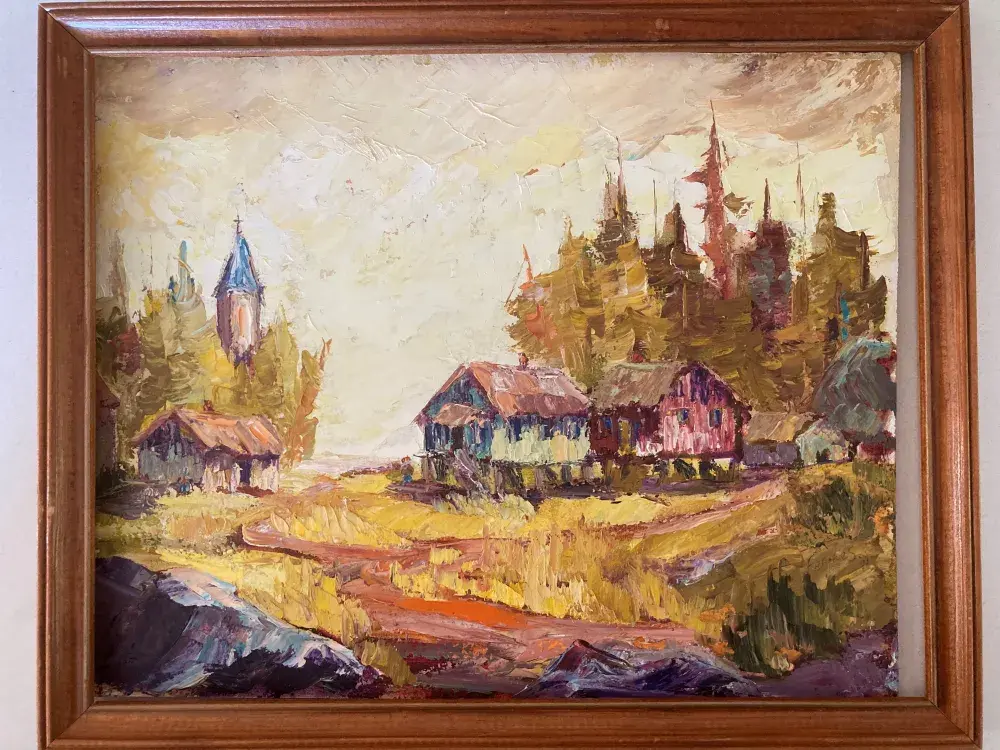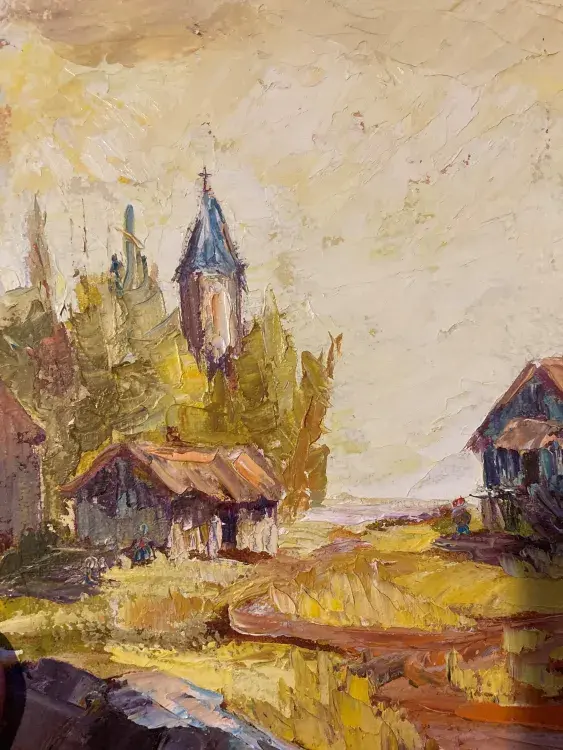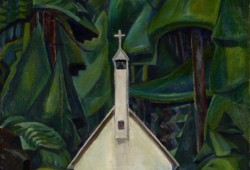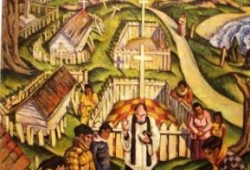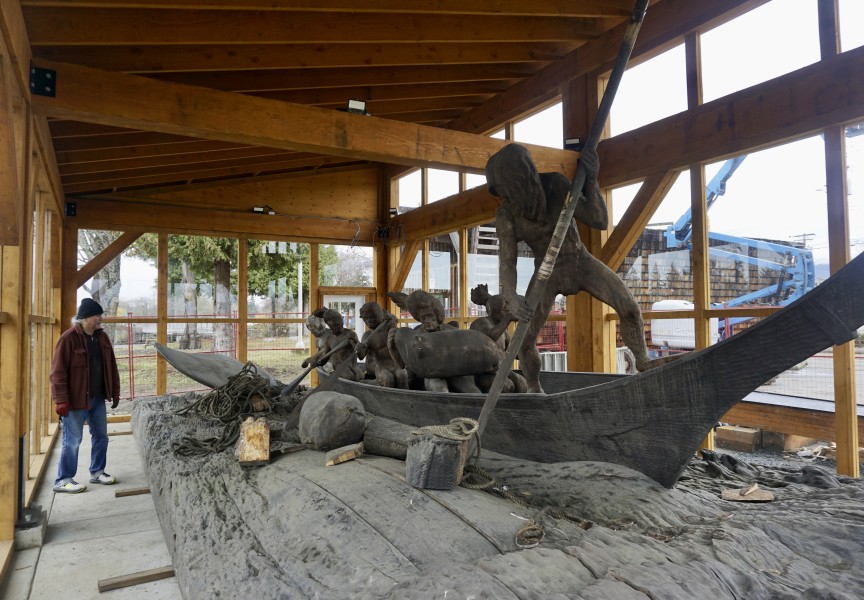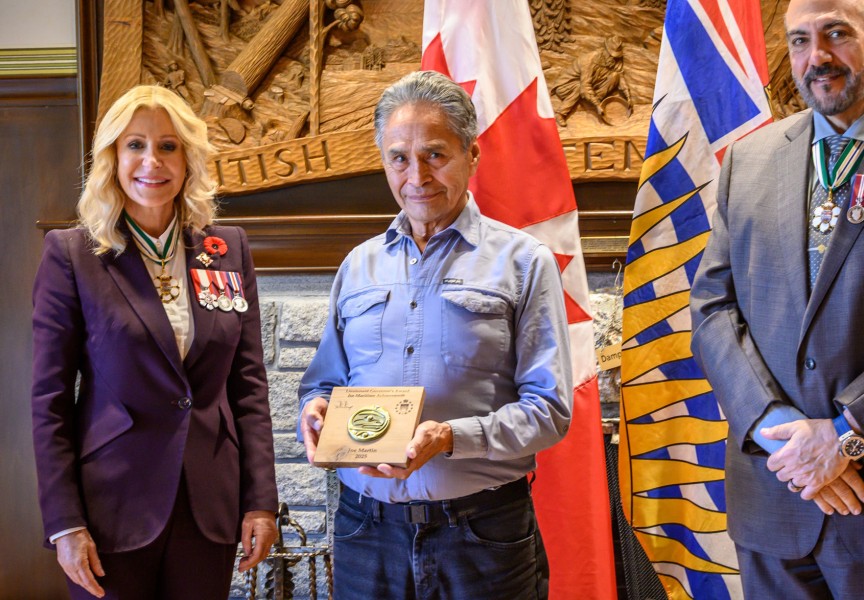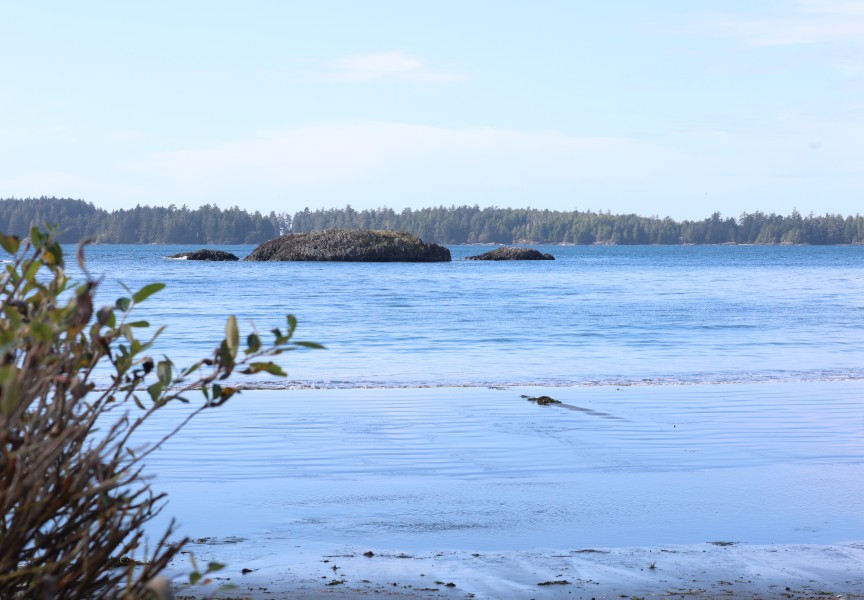A woman shopping at a thrift store in Nelson, BC is intrigued by a framed painting. The thick, brilliantly coloured, oil paint brought to life a scene of a small, rugged settlement surrounded by rocks and forests. Priced at only $1, the woman took the beautiful painting home.
Entitled ‘Friendly Cove’, the color painting features a cluster of houses, some on stilts, surrounded by lush, green forests. In the background, peeking over the tree tops is the steeple of a church. On the back of the painting, printed in block letters are the words, ‘Friendly Cove, sketched 1963’ and appears to be signed France Sue (Prior) McIntyre.
Dawn Slye emailed Ha-Shilth-Sa in late September. She wrote that she bought the painting that very day, at a thrift shop in Nelson, BC. Slye says she goes “thrifting” fairly often, hitting up stores between her home near Nelson, BC and Vancouver.
“I am an artist also, with a passion for photography and history – I see it (thrifting) as a rescue mission,” she said.
Slye says she looks for beautiful paintings, photography, books…whatever catches her eye.
“I love old photographs, cookbooks with handwritten recipes tucked inside,” she told Ha-Shilth-Sa.
These things, she said, are hard to find, but can be a real treasure when one pops up.
On that day in late September, Slye was rummaging through bins at her local thrift store when she saw a brightly colored canvas.
“I could tell it was an oil painting, falling out of its frame,” Slye recalled.
Flipping the painting over, she saw, written on the back, the words Friendly Cove.
“It was priced at $2 but there was a 50 per cent off sale that day,” said Slye.
Once she bought the painting, the research started.
“I had never heard of Friendly Cove, even though I had lived and explored Vancouver Island for many years, but looked into it and thought I’d share a bit of your history with you!” Slye wrote in an email to Ha-Shilth-Sa.
Through research, Slye discovered that a place known as Friendly Cove exists. Today, it is known by its Mowachaht name, Yuquot.
Slye sent photos of the painting, front and back to Ha-Shilth-Sa. She says the painting is tiny, about 11 by 14 inches. What struck her most is the richness of colors.
“I thought the color of the sky was intriguing. Most artists make their skies blue,” Slye said. “But this one is yellow and ochre, it has that misty morning feel.”
What is known about the painting, based on information printed on the back, is that it was sketched in Friendly Cove in 1963, when there would have been more people living there. The sketch wasn’t painted until 1971, according to the signature and date painted on the front.
“I’m glad the person signed, dated and named it,” said Slye.
Ha-Shilth-Sa searched names on the back of the painting but could not identify an artist. Slye says the painting has helped her learn about learn about Yuquot’s history. For now, the little painting is hung on her wall for her family to enjoy.
With its rugged beauty and rich history, Yuquot has long been an inspiration for artists. It is the place of first contact on the Northwest Pacific Coast with England’s Captain James Cook in 1778, followed by Spaniards in 1789. Drawings of scenes from the village were made by artists accompanying both sets of explorers.
In more recent times, Yuquot was the inspiration for some of the works of notable artists like Emily Carr (1871-1945) and Jock McDonald (1897-1960).
It was in 1928 that Emily Carr spent time in Yuquot, sketching scenes from the village, including the little white church that was to become her most famous painting.
Intrigued by Indigenous art, Carr began travelling to B.C.’s coastal First Nations villages to see the totem poles and other carvings that were rapidly disappearing from the landscape. In 1898 she went to Ucluelet and visited with the Yuułuʔiłʔatḥ. It was there that she was given the name Klee Wyck. Her first book was entitled Klee Wyck.
In 1929, Carr’s painting she named ‘Indian Church’ was complete. The church was a simplified version of an older church that had burnt down and was replaced. In the painting, the stark, white church is flanked by rows of simple white crosses protected by picket fences.
Indian Church was Carr’s most famous painting. It was renamed, in consultation with the Mowachaht/Muchalaht First Nation in 2018. The painting is now called ‘Church in Yuquot Village’.
In 1935, Scottish/Canadian artist Jock McDonald and his family boarded the SS Maquinna destined for Yuquot. According to his biography by the Art Institute of Canada, McDonald hoped seeing the natural beauty of Vancouver Island would give him “spiritual expression” – that, and he was looking for land to buy.
Unable to find suitable property to buy, and running out of money, McDonald sent several of his Yuquot sketches to a dealer in Vancouver. He sold his oil on canvas painting, ‘Friendly Cove’, for $350, enough to get his family through the winter.
A back injury in 1936 ended the McDonald family’s time in Yuquot and they returned to Vancouver. But sketches from the village were transformed into paintings, sustaining the family into the future.
He supplemented his teacher’s salary with art sales, starting with the 1937 painting called Indian Burial, which shows a Yuquot burial scene, the subjects dressed in contemporary clothing.
Other paintings made from McDonald’s Yuquot sketches were Nootka Lighthouse in 1936, Pilgrimage in 1937, Drying Herring Roe in 1938 and B.C. Indian Village in 1943.
In 1939 McDonald was commissioned by Hotel Vancouver to paint a mural on the dining room wall. The mural was a scene from Yuquot featuring a house with a woman and child standing in front. They are surrounded by totem poles, forests and mountains. Jutting from the tree tops in the background, is a church steeple.
Sadly, this mural no longer exists, likely destroyed during renovations.
It’s been nearly a century since Emily Carr first painted her impressions of Yuquot. The Catholic church featured in the Carr and McDonald paintings is gone, replaced by a similar-looking white church. It is this replacement church that the mystery artist saw in 1963, when she made her sketches.
In 1963 more people lived at Yuquot, but they moved away at the behest of the federal government. The houses in the paintings are long gone. But the natural beauty of Yuquot, still showing remnants of the distant past juxtaposed with modern construction, remains a place of inspiration for artists.

